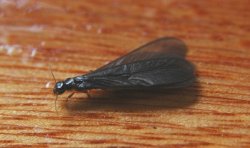Termites
 Termites are extremely important in nature. They recycle fallen trees and other materials back into the soil. Termites are needed in our environment, however, a termite cannot tell the difference between a log and a board in your home. Therefore, homeowners must understand termites and the current control methods available to them.
Termites are extremely important in nature. They recycle fallen trees and other materials back into the soil. Termites are needed in our environment, however, a termite cannot tell the difference between a log and a board in your home. Therefore, homeowners must understand termites and the current control methods available to them.
Subterranean Termites
Subterranean termite groups consist of two important types: the native eastern subterranean termites and the Formosan termite, both are native to every state except Alaska, causing more than $750,000,000 of damage each year in the United States alone. Termites, given enough time, can cause enough damage to lead to sagging floors, damaged carpets and trim, damaged wallpaper, and eventually threaten the structural integrity of your home or structure. Successful control of termites nearly always requires the services of a qualified pest control firm.
Subterranean termites are social insects that live in nests or colonies in the soil. Termite colonies can range from hundreds of thousands to millions with colonies attacking more than one structure. The members of these colonies divide their work among specialized members. The members of these colonies move in passageways that are hidden from the sun’s rays and are protected from undue moisture loss. Three castes make up the termite colony (reproductives, workers, and soldiers). Reproductives can be winged (primary) or wingless (secondary). Each has the capability to produce new offspring. Primary reproductives, also called swarmers, vary in body color from coal black to pale yellow-brown. The wings are 1/4 to 3/8 inch long. Termite workers are wingless, white to grayish-white, 1/4 to 3/8 inch long and make up the largest number of individuals within the colony. Soldiers resemble the workers in color and general appearance. However, they have a large, well-developed, brownish head with strong mandibles or jaws. Soldiers defend the colony against invaders which are primarily ants. Once a colony is several years old and relatively large another form of adult termite may be produced called a “swarmer”. Swarmers have four wings, range in size from 3/8 to 1/4 inch, and are often brown or black in appearance. Swarmers are a colonies way of sending out new kings and queens t start colonies of their own. In the spring large numbers of swarmers can fly from a single colony. Swarmers are the most visible form of termite in and around the home. The homeowner usually realizes that they have a problem with termites when these swarmers are seen. Termite swarmers are often times confused with many ants that also swarm in the spring. If you look closely, you can see that swarming ants have elbowed antennae, a narrow waist, and front wings that are longer than the back wings. Swarming termites have straight antennae, a thick waist, and all the wings are the same length. Mature Formosan termite colonies may have millions of workers. For this reason these termites are usually the most destructive. Subterranean termites usually live underground, excavating the soil in the form of passageways to reach wood. Their passageways can be rather complex extending over 10 feet under the ground and cover more than an acre. The soil provides these termites moisture which protects them from drying and helps shield them from predators. If, however, water and wood is available from a source other than the soil, it is possible for these termites to establish a colony above the ground. This is more so the case with the Formosan termite.
